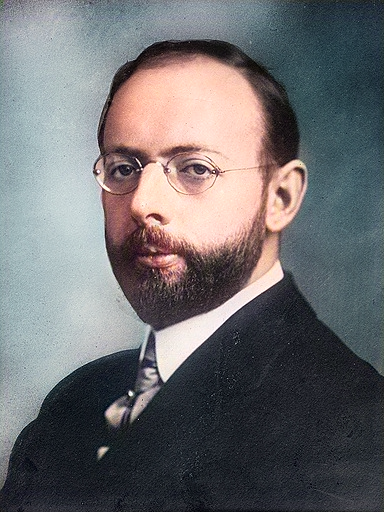
Herbert Eugene Ives (1882 – 1953)
On November 13, 1953, US-American scientist and engineer Herbert Eugene Ives passed away. Ives headed the development of facsimile and television systems at AT&T. He is best known for the 1938 Ives–Stilwell experiment, which provided direct confirmation of special relativity’s time dilation, although Ives himself did not accept special relativity, and argued instead for an alternative interpretation of the experimental results.
Herbert Eugene Ives – Background
Herbert Eugene Ives was born on July 31, 1882 in Philadelphia, Pennsylvania, USA, the son of to Frederic Eugene Ives and Mary Olmstead. He studied at the University of Pennsylvania and the Johns Hopkins University, where he graduated in 1908. Just like his father, Herbert Ives became an expert in color photography. In 1924, he he demonstrated 185-line long-distance television, transmitting the live video images of then-Secretary of Commerce Herbert Hoover via AT&T’s experimental station 3XN in Whippany, New Jersey, allowing media reporters to both see and communicate with Hoover.
The Two-Way Television-Telephone
By 1930, Ives’ two-way television-telephone system was in regular experimental use. Bell Labs’ large New York City research facility devoted years of research and development through the 1930s, led by Ives with his team of more than 200 scientists, engineers and technicians. After years of ongoing research on audio and video telephones at Bell Labs, Ives and numerous researchers managed to develop AT&T’s futuristic Picturephone.
The Ives-Stilwell Experiment
After the philosophy of Hendrik Lorentz, Herbert Eugene Ives attempted to demonstrate the physical reality of relativistic effects by means of logical arguments and experiments. Ives became best known for conducting the famous Ives–Stilwell experiment. It provided direct confirmation of special relativity’s time dilation. The Ives–Stilwell experiment tested the contribution of relativistic time dilation to the Doppler shift of light. The result was in agreement with the formula for the transverse Doppler effect, and was the first direct, quantitative confirmation of the time dilation factor. Since then, many Ives–Stilwell type experiments have been performed with increased precision. Together with the Michelson–Morley and Kennedy–Thorndike experiments, it forms one of the fundamental tests of special relativity theory.
And a Wrong Interpretation
However, Ives himself regarded his experiment as a proof of the existence of the ether and hence, as he erroneously suggested, a disproof of the theory of relativity. He was further discouraged by the reaction of the scientific community that had interpreted his experiment in the way opposite to his expectations.
Ives held honorary degrees from Yale University, Dartmouth College, and the University of Pennsylvania. In 1951, he received the Rumford Prize of the American Academy of Arts and Sciences. For his service in World War II, he received the Medal for Merit in 1948 for his war-time work on blackout lighting and optical communication systems. He was an avid coin collector and served as president of the American Numismatic Society from 1942 to 1946.
Herbert Eugene Ives died on November 13, 1953 in Upper Montclair, New Jersey at age 71.
Mark Ancliff, Modern Physics 7-3: The Ives-Stilwell Experiment, [7]
References and Further Reading:
- [1] Oliver E. Buckley, Karl K. Darrow: Herbert Eugene Ives. A Biographical Memoir. Hrsg.: National Academy of Sciences (= Biographical Memoirs of the NAS). Washington D.C. 1956, S. 145–189
- [2] The experimental basis of Special Relativity at the University of California, Riverside
- [3] Ives, H. E. & Stilwell, G. R. (1938): An experimental study of the rate of a moving clock. J. Opt. Soc. Am. 28, 215–226
- [4] Ives, H. E. & Stilwell, G. R. (1941): An experimental study of the rate of a moving clock. II. J. Opt. Soc. Am. 31, 369–374
- [5] Dr. Herbert Ives, Pioneer In TV, Dies. Researcher on Electron-Optics Developed 3-D Photography, Wirephoto Transmission”. New York Times. November 15, 1953.
- [6] H.E.Ives, G.R.Stilwell, An experimental study of the rate of a moving atomic clock, Journal of the Optical Society of America, Vol. 28, Iss. 7, pp. 215–226 (1938).
- [7] Mark Ancliff, Modern Physics 7-3: The Ives-Stilwell Experiment, Mark Ancliff @ youtube
- [8] Herbert Eugene Ives at Wikidata
- [9] Timeline of Relativity Critics, via Wikidata and DBpedia






Pingback: Whewell’s Gazette: Year 3, Vol. #14 | Whewell's Ghost
SRT is completely erroneous since it is based on the wrong kind of transformations: they have lost the scale factor characterizing the Doppler effect. First, Lorentz considered a more general form of transformations (with a scale factor), but then he, and also Poincare and Einstein equated it 1 without proper grounds. Their form was artificially narrowed, the formulas became incorrect. This led to a logical contradiction of the theory, to unsolvable paradoxes. Accordingly, GRT is also incorrect.
For more details, see my brochure “Memoir on the Theory of Relativity and Unified Field Theory” (2000):
http://vixra.org/abs/1802.0136